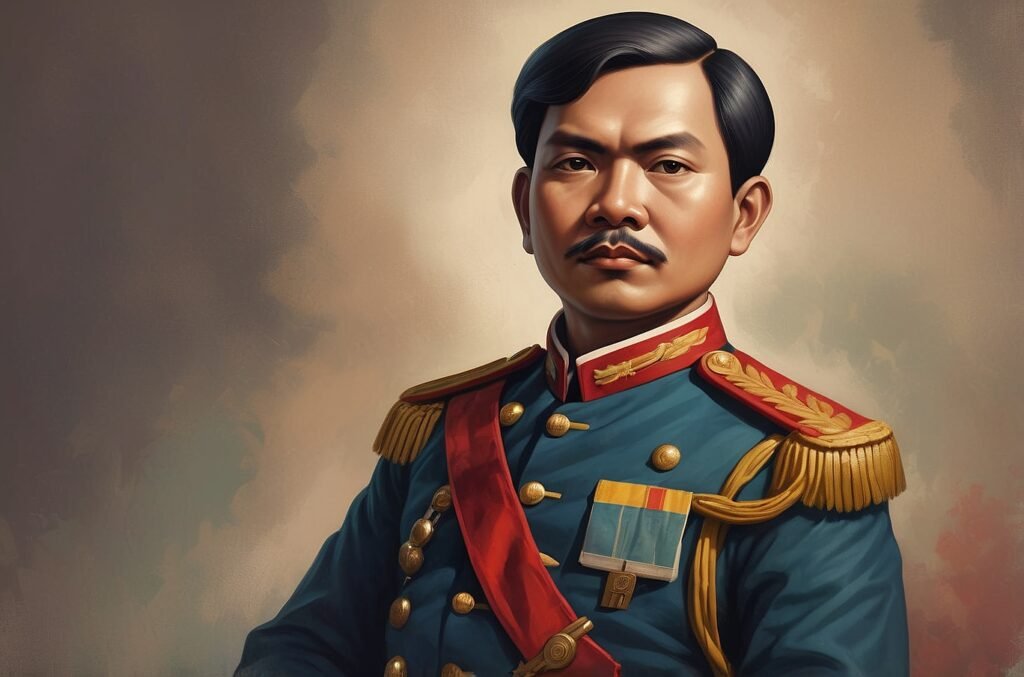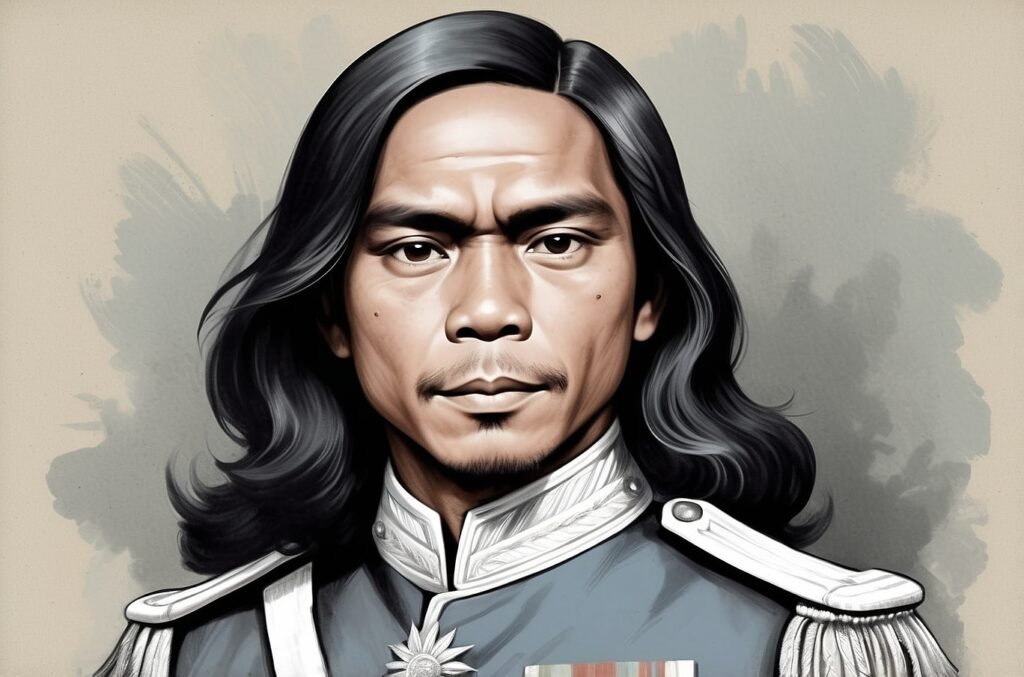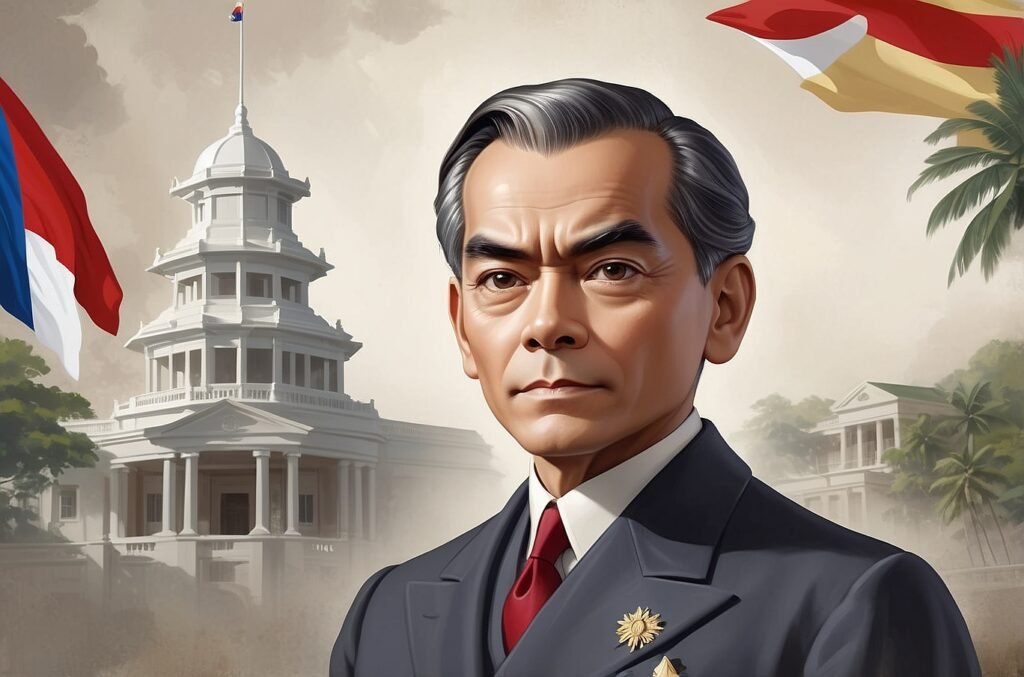Artemio Ricarte, known by his sobriquet “Vibora” (Viper), stands as a towering figure in Philippine history, embodying the spirit of unwavering revolution against colonial rule. His life, spanning from 1866 to 1945, was marked by an unyielding commitment to Philippine independence, first against Spanish colonialism and later against American occupation. This blog delves into the life, struggles, and legacy of this controversial yet significant Filipino revolutionary, exploring his role in shaping the nation’s path to sovereignty and his enduring influence on Philippine nationalism.
Early Life and Education
Birth and Family Background
Artemio Ricarte was born on October 20, 1866, in Batac, Ilocos Norte, Philippines. His parents, Faustino Ricarte and Bonifacia García, were of modest means but placed great importance on education. The Ricarte family, like many in the region, lived under the Spanish colonial system that had governed the Philippines for over three centuries. This environment would significantly shape young Artemio’s worldview and future aspirations.
Educational Journey
Ricarte’s formal education began in his hometown of Batac, where he exhibited a keen intellect and thirst for knowledge from an early age. His academic prowess led him to pursue higher education in Manila, the colonial capital. In 1886, he enrolled at the Escuela Normal de Maestros, an institution dedicated to training teachers. This decision would prove pivotal, not only for Ricarte’s personal development but also for the revolutionary cause he would later champion.
During his time at the Escuela Normal, Ricarte was exposed to liberal ideas and nationalist sentiments that were beginning to circulate among the educated Filipino elite. The school environment, coupled with the broader sociopolitical climate of the late 19th century Philippines, fostered in Ricarte a growing awareness of colonial injustices and a burgeoning sense of Filipino identity. These formative years laid the groundwork for his future role as a revolutionary leader.
Early Career and Political Awakening
Upon completing his studies, Ricarte embarked on a teaching career, a profession that allowed him to observe firsthand the inequalities perpetuated by the Spanish colonial system. As a teacher, he had the opportunity to influence young minds and subtly instill nationalist ideals. However, Ricarte’s political consciousness continued to evolve, driven by the growing discontent among Filipinos and the nascent independence movement gaining momentum across the archipelago.
Rise as a Revolutionary
Joining the Katipunan
In 1896, Ricarte took a decisive step that would alter the course of his life and place him at the forefront of the Philippine Revolution. He joined the Katipunan, a secret revolutionary society founded by Andrés Bonifacio. The Katipunan, short for “Kataas-taasang, Kagalang-galangang Katipunan ng mga Anak ng Bayan” (Highest and Most Honorable Society of the Children of the Nation), sought to overthrow Spanish rule through armed rebellion.
Ricarte’s initiation into the Katipunan marked his transition from a teacher with nationalist leanings to an active participant in the struggle for independence. His dedication, strategic acumen, and leadership qualities quickly became apparent, earning him rapid promotions within the organization’s ranks.
Military Leadership and Strategic Contributions
As the Philippine Revolution erupted in August 1896, Ricarte emerged as a key military leader. His tactical skills and bravery in battle earned him the nickname “Vibora” (Viper), a moniker that reflected his cunning and ferocity in combat against Spanish forces. Ricarte played a crucial role in several significant engagements, demonstrating his ability to mobilize and lead revolutionary forces effectively.
One of Ricarte’s most notable contributions during this period was his involvement in the Tejeros Convention of March 22, 1897. This pivotal meeting aimed to establish a revolutionary government and elect its officials. Ricarte was elected as Captain General of the revolutionary army, a testament to the high regard in which he was held by his fellow revolutionaries. However, the convention also sowed seeds of discord within the revolutionary ranks, particularly between supporters of Bonifacio and those of Emilio Aguinaldo.
The Biak-na-Bato Republic and Exile
The revolutionary struggle against Spain reached a critical juncture with the establishment of the Biak-na-Bato Republic in 1897. Ricarte played a significant role in this short-lived government, serving as its Captain General. However, the republic was dissolved following the Pact of Biak-na-Bato, an agreement that led to a temporary cessation of hostilities and the exile of revolutionary leaders, including Ricarte, to Hong Kong.
During his exile, Ricarte remained committed to the cause of Philippine independence. He used this time to refine his revolutionary ideals, maintain connections with fellow exiles, and prepare for the eventual resumption of the struggle. The experience of exile also broadened Ricarte’s perspective, exposing him to international viewpoints and reinforcing his conviction that the Philippines deserved its place among sovereign nations.
The Philippine-American War
Return to the Philippines and Renewed Struggle
The outbreak of the Spanish-American War in 1898 dramatically altered the political landscape in the Philippines. As American forces engaged Spanish troops in the archipelago, Filipino revolutionaries saw an opportunity to finally achieve independence. Ricarte, along with other exiled leaders, returned to the Philippines to resume the fight for freedom.
Initially, there was a sense of cautious optimism among Filipino revolutionaries regarding American intentions. However, this hope quickly gave way to disillusionment as it became clear that the United States had its own colonial ambitions for the Philippines. The Philippine-American War, which officially began in 1899, saw Ricarte once again take up arms, this time against a new colonial power.
Military Campaigns and Guerrilla Warfare
During the Philippine-American War, Ricarte distinguished himself as a skilled military strategist and an indomitable spirit in the face of overwhelming odds. He led numerous campaigns against American forces, employing guerrilla tactics that proved effective in challenging the technologically superior U.S. military. Ricarte’s leadership inspired many Filipinos to continue the resistance, even as other revolutionary figures began to consider surrender or collaboration.
The following table summarizes some of the key military engagements in which Ricarte played a significant role during the Philippine-American War:
| Date | Battle/Campaign | Ricarte’s Role | Outcome |
|---|---|---|---|
| 1899 | Battle of Manila | Commander of Filipino forces | American victory, but Ricarte’s tactics delayed U.S. advance |
| 1900 | Ilocos Campaign | Guerrilla leader | Successful raids against American outposts |
| 1901 | Defense of Abra | Strategic coordinator | Prolonged resistance in the region |
| 1902 | Batangas operations | Adviser to local guerrilla units | Sustained Filipino resistance despite American “pacification” efforts |
Capture and First Exile
Despite his tactical prowess and unwavering commitment, Ricarte was eventually captured by American forces in 1900. He was initially sentenced to be executed but was later offered clemency on the condition that he swear allegiance to the United States. Ricarte steadfastly refused, preferring exile to what he saw as a betrayal of the Philippine cause.
In 1901, Ricarte was deported to Guam, along with other Filipino revolutionaries who refused to submit to American authority. This first period of exile under American rule further hardened Ricarte’s resolve and cemented his reputation as an uncompromising advocate for Philippine independence.
Life in Exile and Continued Resistance
Years in Hong Kong and Japan
After his release from Guam in 1903, Ricarte chose to live in exile rather than return to a Philippines under American colonial rule. He first settled in Hong Kong, where he joined a community of Filipino expatriates and continued to advocate for independence. Despite being away from his homeland, Ricarte remained actively engaged in planning and supporting resistance efforts.
In 1915, Ricarte moved to Japan, a decision that would have significant implications for his later life and legacy. During his time in Japan, he continued his anti-colonial activities, writing and speaking out against American rule in the Philippines. He also closely observed Japan’s rising power and its potential as an ally in the struggle against Western imperialism in Asia.
Ideological Development and Writings
Ricarte’s years in exile were not merely a period of waiting; they were a time of intense intellectual and ideological development. He penned several works during this period, including his memoirs and political treatises that outlined his vision for an independent Philippines. Some of his notable writings include:
- “Himagsikan nang manga Pilipino Laban sa Kastila” (The Revolution of Filipinos Against the Spanish)
- “Mga Gunita ng Himagsikan” (Memories of the Revolution)
- “Ang Kasaysayan ng Pilipinas” (The History of the Philippines)
These works not only served as historical accounts but also as ideological manifestos, articulating Ricarte’s unwavering commitment to complete Philippine independence and his critique of what he saw as compromised or collaborationist elements within the Filipino political elite.
Networking and Support for Philippine Independence
Throughout his exile, Ricarte maintained an extensive network of contacts both within the Philippines and among the Filipino diaspora. He corresponded with sympathizers, fellow revolutionaries, and even some American anti-imperialists who supported Philippine independence. This network allowed him to stay informed about developments in the Philippines and to continue influencing the independence movement from afar.
Ricarte’s activities during this period can be summarized in the following chart:
graph TD
A[Artemio Ricarte in Exile] --> B[Writing and Ideological Work]
A --> C[Networking]
A --> D[Planning Resistance]
B --> E[Memoirs and Historical Accounts]
B --> F[Political Treatises]
C --> G[Filipino Diaspora]
C --> H[Sympathizers in Philippines]
C --> I[Anti-Imperialist Americans]
D --> J[Strategizing for Future Resistance]
D --> K[Seeking International Support]Return to the Philippines and World War II
The Japanese Invasion and Ricarte’s Controversial Role
The outbreak of World War II and Japan’s invasion of the Philippines in 1941 presented Ricarte with what he saw as an opportunity to finally realize his dream of Philippine independence. In December 1941, he returned to the Philippines accompanying Japanese forces. Ricarte believed that Japan would grant the Philippines true independence, free from Western colonial influence.
This decision remains one of the most controversial aspects of Ricarte’s legacy. While he maintained that his actions were motivated solely by his desire for Philippine sovereignty, his association with the Japanese occupation forces led many to view him as a collaborator. The complex geopolitical situation of the time, coupled with Ricarte’s long-standing anti-American stance, created a morally ambiguous position that continues to be debated by historians.
Activities During the Japanese Occupation
During the Japanese occupation of the Philippines (1942-1945), Ricarte held various positions within the Japanese-sponsored government. His roles included:
- Advisor to the Japanese military administration
- Proponent of the Kapisanan sa Paglilingkod sa Bagong Pilipinas (Association for Service to the New Philippines)
- Advocate for Filipino cooperation with Japanese authorities
Ricarte’s actions during this period were driven by his belief that Japan would fulfill its promise of granting independence to the Philippines. He worked to mobilize Filipino support for the Japanese-backed government, arguing that this was the path to true national sovereignty. However, as the brutality of the Japanese occupation became apparent, Ricarte’s position became increasingly untenable.
Final Days and Death
As the tide of the war turned against Japan, Ricarte found himself in an increasingly precarious position. The promise of independence under Japanese auspices had proven hollow, and the Filipino people had suffered greatly under the occupation. Despite this, Ricarte remained committed to his principles, refusing to abandon his long-held dream of a fully independent Philippines.
In the chaotic final days of the Japanese occupation, as American forces advanced to retake the Philippines, Ricarte fled with retreating Japanese troops. He died on July 31, 1945, in Hungduan, Ifugao Province, reportedly of dysentery. His death came just weeks before Japan’s surrender and the end of World War II.
Legacy and Historical Assessment
Controversial Figure in Philippine History
Artemio Ricarte’s legacy remains a subject of intense debate among historians and Filipino nationalists. His unwavering commitment to Philippine independence and his refusal to compromise with colonial powers have earned him admiration in some quarters. However, his association with the Japanese occupation forces during World War II has led others to view him as a traitor or collaborator.
The following table presents some of the contrasting views on Ricarte’s legacy:
| Positive Assessments | Negative Assessments |
|---|---|
| Unwavering patriot | Collaborator with Japanese occupation |
| Symbol of Filipino resistance | Misguided idealist |
| Principled revolutionary | Betrayer of Filipino interests |
| Advocate for complete independence | Enabler of wartime atrocities |
Impact on Philippine Nationalism
Despite the controversies surrounding his later years, Ricarte’s influence on Philippine nationalism is undeniable. His early revolutionary activities and his steadfast refusal to swear allegiance to the United States helped shape the discourse on Philippine independence throughout the first half of the 20th century. Ricarte’s writings and ideological contributions continue to be studied by scholars of Philippine history and nationalism.
Historical Reassessment and Continuing Debates
In recent years, there has been a growing effort among historians to reassess Ricarte’s life and legacy in a more nuanced light. This reassessment takes into account the complex geopolitical realities of his time and seeks to understand his actions within the broader context of anti-colonial struggles in Asia.
Some key points of historical debate include:
- The extent of Ricarte’s influence on the Philippine Revolution and the Philippine-American War
- The motivations behind his collaboration with Japanese forces
- The impact of his uncompromising stance on the trajectory of the Philippine independence movement
- The relevance of his ideological writings to contemporary Filipino nationalism
Conclusion
Artemio Ricarte, the “Vibora” of the Philippine Revolution, remains a complex and controversial figure in the nation’s history. His life story embodies the struggles, contradictions, and difficult choices faced by many in colonized nations during the tumultuous first half of the 20th century. From his early days as a revolutionary against Spanish rule to his final years during the Japanese occupation, Ricarte’s unwavering commitment to his vision of Philippine independence defined his life’s work.
While opinions on Ricarte’s legacy may vary, his impact on Philippine nationalism and the independence movement is undeniable. His story continues to provoke discussion and debate, serving as a reminder of the complex nature of national identity, revolution, and the pursuit of sovereignty in the face of colonial powers. As the Philippines continues to grapple with questions of national identity and its place in the global community, the life and legacy of Artemio Ricarte remain relevant subjects for historical inquiry and reflection.
Disclaimer: This blog post is based on historical research and aims to present a balanced view of Artemio Ricarte’s life and legacy. However, given the controversial nature of some aspects of his life, readers are encouraged to engage with a variety of sources to form their own informed opinions. If you notice any inaccuracies in this article, please report them so we can promptly make corrections and ensure the accuracy of the information presented.




